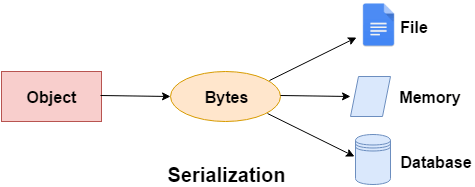📌 相关文章
- C#序列化(1)
- 序列化与反序列化 (1)
- 序列化和反序列化 (1)
- 序列化和反序列化 N 叉树(1)
- C#反序列化
- C#反序列化(1)
- 序列化和反序列化 N 叉树
- javascript中的序列化和反序列化(1)
- Java中的序列化和反序列化
- Java中的序列化和反序列化(1)
- Java中的序列化和反序列化示例
- javascript代码示例中的序列化和反序列化
- 序列化和反序列化 - 无论代码示例
- 序列化与反序列化 - 无论代码示例
- 序列化和反序列化字符串数组(1)
- 序列化和反序列化字符串数组
- 什么是 java 中的序列化和反序列化 (1)
- 序列化和反序列化二叉树
- 序列化和反序列化二叉树(1)
- Java中的自定义序列化和反序列化(1)
- Java中的自定义序列化和反序列化
- Java-序列化(1)
- Java-序列化
- Java-序列化
- 序列化 php (1)
- 反序列化 php (1)
- 是序列化的 PHP (1)
- 什么是 java 中的序列化和反序列化 - 任何代码示例
- 字符串和序列化(1)
📜 C#序列化
📅 最后修改于: 2020-10-31 04:20:32 🧑 作者: Mango
C#序列化
在C#中,序列化是将对象转换为字节流以便可以将其保存到内存,文件或数据库的过程。序列化的相反过程称为反序列化。
序列化在远程应用程序内部使用。

C#SerializableAttribute
要序列化对象,您需要将SerializableAttribute属性应用于该类型。如果您不将SerializableAttribute属性应用于该类型,则在运行时会引发SerializationException异常。
C#序列化示例
让我们看一下C#中序列化的简单示例,其中我们要序列化Student类的对象。在这里,我们将使用BinaryFormatter.Serialize(stream,reference)方法来序列化对象。
using System;
using System.IO;
using System.Runtime.Serialization.Formatters.Binary;
[Serializable]
class Student
{
int rollno;
string name;
public Student(int rollno, string name)
{
this.rollno = rollno;
this.name = name;
}
}
public class SerializeExample
{
public static void Main(string[] args)
{
FileStream stream = new FileStream("e:\\sss.txt", FileMode.OpenOrCreate);
BinaryFormatter formatter=new BinaryFormatter();
Student s = new Student(101, "sonoo");
formatter.Serialize(stream, s);
stream.Close();
}
}
sss.txt:
JConsoleApplication1, Version=1.0.0.0, Culture=neutral, PublicKeyToken=null Student rollnoname e sonoo
如您所见,序列化的数据存储在文件中。要获取数据,您需要执行反序列化。